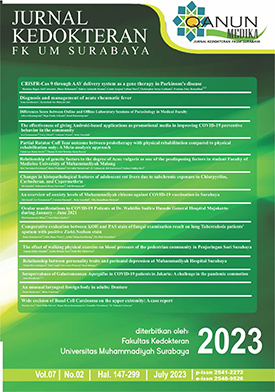CRISPR-Cas9 through AAV delivery system as a gene therapy in Parkinson’s disease
Abstract
The global population living with Parkinson’s disease is estimated to reach 9.4 million people, which has increased significantly since 2016, with a total of 6 million people. Parkinson's is a neurodegenerative disease of the substantia nigra that causes a decrease in dopamine production and is characterized by the appearance of cytoplasmic misfold proteins called Lewy bodies. The study found that abnormalities or mutations in the SNCA and LRRK2 genes correlated with the overproduction of the ɑ-synuclein protein, which forms Lewy bodies that cause Parkinson's. Current Parkinson's medications only temporarily replace lost dopamine but do not treat the direct cause of Parkinson's; this research used qualitative literature study with content analysis, observation, and development; the use of CRISPR-Cas9 through AAV genetic engineering in repairing SNCA and LRRK2 mutant gene. This genetic therapy works by cutting the mutant DNA base sequences in the SNCA and LRRK2 genes and then replacing them with normal sequences through a homology-direct repair mechanism. As a result, the abnormalities or mutations that cause Parkinson's in these two genes can be corrected, so that dopaminergic levels in the brain can return to normal and excessive accumulation of α-synuclein protein can be suppressed.
Full text article
References
Artyukhova, M. A., Tyurina, Y. Y., Chu, C. T., Zharikova, T. M., Bayır, H., Kagan, V. E., & Timashev, P. S. (2019). Interrogating Parkinson’s disease associated redox targets: Potential application of CRISPR editing. Free Radical Biology & Medicine, 144, 279–292. https://doi.org/10.1016/j.freeradbiomed.2019.06.007
Cacabelos, R. (2017). Parkinson’s Disease: From Pathogenesis to Pharmacogenomics. International Journal of Molecular Sciences, 18(3). https://doi.org/10.3390/ijms18030551
Cota-Coronado, A., DÃaz-MartÃnez, N. F., Padilla-Camberos, E., & DÃaz-MartÃnez, N. E. (2019). Editing the Central Nervous System Through CRISPR/Cas9 Systems. Frontiers in Molecular Neuroscience, 12, 110. https://doi.org/10.3389/fnmol.2019.00110
Daher, J. P. L. (2017). Interaction of LRRK2 and α-Synuclein in Parkinson’s Disease. Advances in Neurobiology, 14, 209–226. https://doi.org/10.1007/978-3-319-49969-7_11
DeMaagd, G., & Philip, A. (2015). Parkinson’s Disease and Its Management: Part 1: Disease Entity, Risk Factors, Pathophysiology, Clinical Presentation, and Diagnosis. P & T : A Peer-Reviewed Journal for Formulary Management, 40(8), 504–532.
Ellis, J. M., & Fell, M. J. (2017). Current approaches to the treatment of Parkinson’s Disease. Bioorganic & Medicinal Chemistry Letters, 27(18), 4247–4255. https://doi.org/10.1016/j.bmcl.2017.07.075
Fernandez, H. H. (2012). Updates in the medical management of Parkinson disease. Cleveland Clinic Journal of Medicine, 79(1), 28–35. https://doi.org/10.3949/ccjm.78gr.11005
Kantor, B., Tagliafierro, L., Gu, J., Zamora, M. E., Ilich, E., Grenier, C., Huang, Z. Y., Murphy, S., & Chiba-Falek, O. (2018). Downregulation of SNCA Expression by Targeted Editing of DNA Methylation: A Potential Strategy for Precision Therapy in PD. Molecular Therapy : The Journal of the American Society of Gene Therapy, 26(11), 2638–2649. https://doi.org/10.1016/j.ymthe.2018.08.019
Kasandra, F. (2017). Hubungan Antara Penggunaan Obat Antihipertensi Dan Penyakit Parkinson Di Rumah Sakit Bethesda Yogyakarta. Angewandte Chemie International Edition, 6(11), 951–952.
Katzung, Bertram G.; Trevor, A. J. . K.-H. M. (2019). Pharmacology Examination & Board Review (12th ed.). McGraw Hill.
Kearney, E., Giles, R., Haworth, B., Faloutsos, P., Baljko, M., & Yunusova, Y. (2017). Sentence-Level Movements in Parkinson’s Disease: Loud, Clear, and Slow Speech. Journal of Speech, Language, and Hearing Research : JSLHR, 60(12), 3426–3440. https://doi.org/10.1044/2017_JSLHR-S-17-0075
Qing, X., Walter, J., Jarazo, J., Arias-Fuenzalida, J., Hillje, A.-L., & Schwamborn, J. C. (2017). CRISPR/Cas9 and piggyBac-mediated footprint-free LRRK2-G2019S knock-in reveals neuronal complexity phenotypes and α-Synuclein modulation in dopaminergic neurons. Stem Cell Research, 24, 44–50. https://doi.org/10.1016/j.scr.2017.08.013
Rizek, P., Kumar, N., & Jog, M. S. (2016). An update on the diagnosis and treatment of Parkinson disease. CMAJ : Canadian Medical Association Journal = Journal de l’Association Medicale Canadienne, 188(16), 1157–1165. https://doi.org/10.1503/cmaj.151179
Ryan, M., Eatmon, C. V, & Slevin, J. T. (2019). Drug treatment strategies for depression in Parkinson disease. Expert Opinion on Pharmacotherapy, 20(11), 1351–1363. https://doi.org/10.1080/14656566.2019.1612877
Samaila, A., & Hayatudeen, M. R. (2019). Pathophysiology and management of parkinson disease: a review. Bayero Journal of Pure and Applied Sciences, 11(1), 238. https://doi.org/10.4314/bajopas.v11i1.39s
Wang, D., Zhang, F., & Gao, G. (2020). CRISPR-Based Therapeutic Genome Editing: Strategies and In Vivo Delivery by AAV Vectors. Cell, 181(1), 136–150. https://doi.org/10.1016/j.cell.2020.03.023
Xu, C. L., Ruan, M. Z. C., Mahajan, V. B., & Tsang, S. H. (2019). Viral Delivery Systems for CRISPR. Viruses, 11(1). https://doi.org/10.3390/v11010028
Authors
Copyright (c) 2023 Maulana Bagus Adi Cahyono

This work is licensed under a Creative Commons Attribution 4.0 International License.

Qanun Medika by FK UM Surabaya is liscence under Lisensi Creative Commons Atribusi 4.0 Internasional.

